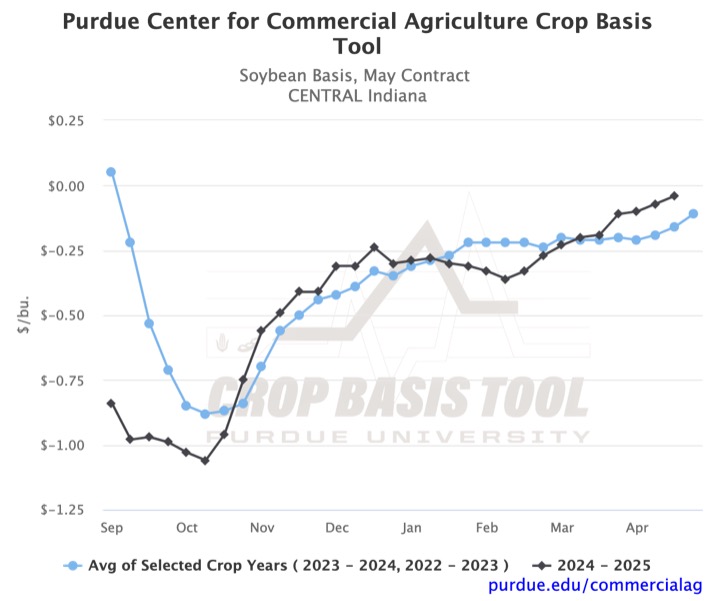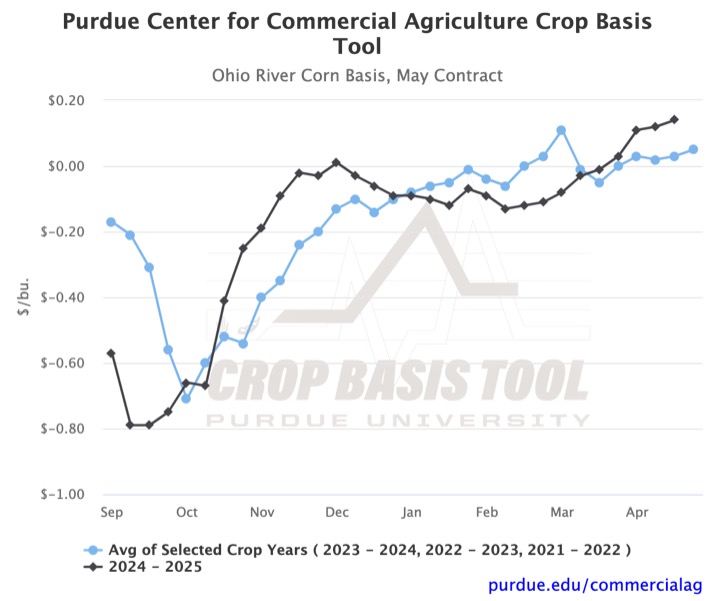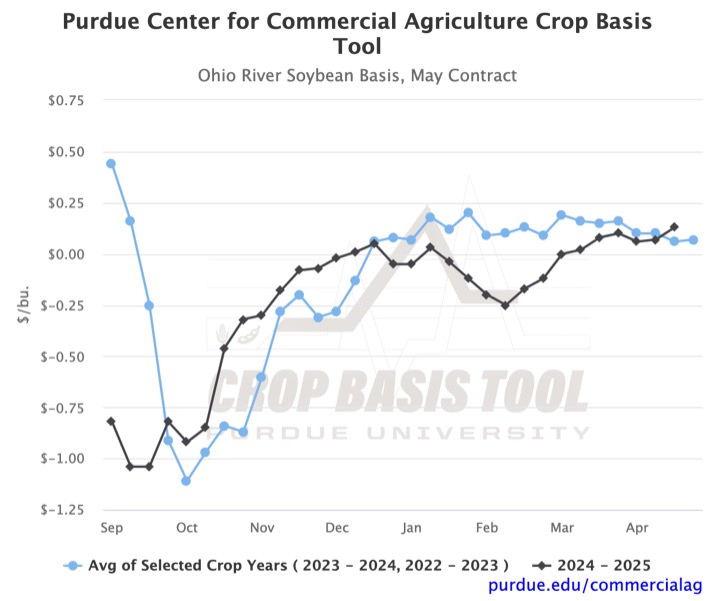April 17, 2025
Trends of Increasing Basis Continue Across the Eastern Corn Belt
by Josh Strine
Strengthening corn and soybean basis levels have been observed across the Eastern Corn Belt for the second straight month. Historically, the basis had exhibited limited movement or slight weakening from February to April. As a result, the gap between the current basis and the historical average has decreased over the past few months, and in many cases, the 2024 – 2025 basis is now higher than the three (two) year trends for corn (soybeans). As a result of the recent strengthening, many terminal elevators, including ethanol plants and soybean processors, and elevators on the Ohio River now have a positive basis.
Central Indiana corn basis for May futures (Figure 1) provides a snapshot of the trend that can be found across the Eastern Corn Belt. Since the first week of February, the basis has increased by $0.16/bu. to -$0.25/bu. as of April 16th. The three-year average would have suggested only slight strengthening ($0.04/bu.) over the past 10 weeks. The gap between the historical and 2024 – 2025 basis has been cut in half during the time period. Central Indiana soybeans basis for May futures (Figure 2) demonstrates more extreme strengthening over the past two months. The region’s soybean basis has increased by $0.29/bu. over the past two months to -$0.04/bu. The current basis is now greater than the two-year average due to the recent strengthening. As a result of recent strengthening, many districts are experiencing the highest basis levels of the marketing year.
Cash prices at the Ohio River are now greater than May futures prices following increases over the past two months (Figures 3 and 4). As of April 16th, the corn basis was $0.14/bu., and the soybean basis was $0.13/bu. Similar trends can be seen in several state-level ethanol and soybean processor basis levels. Based on current basis levels, corn has a greater price premium at the river in Indiana and Illinois, while ethanol plants pay a higher premium in Illinois. On the other hand, soybean processors aggregated at the state level are paying more than delivery points on the river in Illinois, Indiana, and Ohio.
Looking ahead, historical trends suggest the basis may continue to increase slightly or level off over the next one to two months. Weekly basis to July contracts have peaked in May or June over the past two to three years. In regions or markets where the basis is below the historical average, greater strengthening would be required to converge to the historical average. On the other hand, strengthening may be dampened in regions where the 2024 – 2025 basis is above the historical average. To view your local crop basis, check out the Purdue Center for Commercial Agriculture Crop Basis Tool.
TAGS:
TEAM LINKS:
RELATED RESOURCES
UPCOMING EVENTS
December 1 & 8, 2025
Join Purdue Extension for a two-part workshop designed to help you gain a clearer understanding of tax planning essentials. The first session on December 1 will focus on the fundamentals of farm taxes, with particular emphasis on strategies that can be used in a low net income year. The second session on December 8 will focus on key tax strategies and will allow plenty of time for questions. Registration cost is only $20.
Read MoreDecember 15, 2025
This program provides in-depth coverage of agricultural and farm tax issues. In addition to covering timely tax issues, we will cover disaster tax issues, depreciation and expensing farm assets, retirement planning for farms, and tax planning in low-income years. This year’s webinar will be co-taught by a team from Ohio State and Purdue Universities.
Read MoreJanuary 27 or 28, 2026
Farm Shield is more than a conference, it’s a commitment to helping agricultural families build resilience and plan for a secure future. Don’t miss this opportunity to protect your legacy!
Read More



